If you’ve been browsing Ethernet cables online you may have seen that they come with names like CAT 5, CAT 6, CAT 7, and CAT 8. And no, we’re not talking about the feline kind of CAT…meow!
So, what does all that mean, and is there any difference between these varied Ethernet cables?
Defining CAT in Ethernet cables
The CAT label in Ethernet cables stands for “category,” which denotes its standard and specification. You can tell which category the cables belong to by the number suffix each one has.
The main difference between the different categories is the rated performance of each. They also have different wire configurations and other variations in how they are made, like how tightly they are wound, and some have inner plastic tubing.
Just like USB cables, Ethernet cables get faster and more efficient with each successive generation released. That’s great news for gamers looking for faster and more reliable cables for lag-free network gaming.
CAT and data transfer speeds
CAT 5 and CAT 5e cables are an early generation of Ethernet cable dating back to the early noughties. CAT 5 cables provide data transmission speeds up to 100Mbps at 100MHz whereas CAT 5e cables are slightly superior providing speeds up to 1,000Mbps at 100MHz. That means CAT 5e cables tend to be a little more stable and less prone to lag than CAT 5 cables.
Both CAT 5 and CAT 5e cable types are quick enough for most household or work-related network needs, whether that be to hook up multiple PCs or external devices like printers. They’re widely used by small offices, schools ,and colleges for things like Hubs, switches, and routers.
That said, since the newer CAT 6 cables have come out, gamers and users needing higher data transfer speeds have homed in on these instead. That’s because CAT 6 cables are 10 times quicker. They provide data transfer speeds up to 10Gbps and at frequencies up to 250Hz.
These cables also have better shielding to prevent electromagnetic interference, so they are less susceptible to cross talk and noise. That makes them even more stable and very suitable for users that do a lot of video conferencing or that work in the cloud — so they’re ideal for professional workplaces and educational facilities like hospitals or government agencies.
Further reading: The best USB-C cables
In the CAT 6 category, there’s also CAT 6e cables, which are a step up again in functionality. CAT 6e cables are capable of transferring data at the same 10Gbps as their CAT 6 counterparts, but they support higher frequencies still (up to 500MHz) — so if you’re looking to build a very stable 10Gbps network these cables will provide even more surety against interference and lag during heavy data loads.
After CAT 6e comes CAT 7 cables. These Ethernet cables again provide quick transfer speeds of up to 10Gbps but they support even faster frequencies up to 600MHz.
The problem with CAT 7 cables, however, is that they were originally made to support GG45 or TERA connectors instead of the more common RJ45 connectors (used in CAT 5, CAT 6, and CAT 6e cables). GG45 and TERA standards were never widely adopted by hardware manufacturers.
CAT 7 cables can be used with RJ45 connectors, but doing so relegates their bandwidth back to that of a CAT 6 or CAT 6e cable, so you won’t get the extra bandwidth benefit.
In case you were wondering, there are also CAT 8 Ethernet cables, which are the fastest Ethernet cables available today. These cables break the 10Gbps data transfer limit of previous generations by using a 2GHz signal to move data up to 20Gbps or 40Gbps.
Because of their very high data transfer speeds and bandwidth, these cables are frequently installed by big businesses like data centers, financial institutions, research institutions, and broadcasting studios that require the very fastest Ethernet connections available.
That said, I have also found a few operators offering installation purely for gamers, so their use in gaming is becoming more popular.
What Ethernet cable is best for PC gaming?
The theoretical answer to that question is of course, a CAT 8 cable. Then again, using a CAT 8 cable isn’t necessarily a practical option for most gamers. It’s speed and bandwidth overkill. You can have a perfectly lag-free gaming experience with an Ethernet cable from a previous generation.
Most gamers won’t be able to utilize the quick speeds of a CAT 8 cable because of limiting factors, like the speed of their primary router or modem. The main reason to get one, though, is if you want to future-proof your Ethernet performance. These cables used to be very expensive, but they’re a lot more affordable now, so getting one won’t break the budget.
That said, gamers can get away with a CAT 6 or CAT 6e cable just fine, since the fastest PC desktop Ethernet cards only currently support up to a maximum 10Gbps transfer speed (cards like the Asus XG-C100C). In fact, even 1Gbps transfer speeds are quick enough for gaming. CAT 6 and CAT 6e cables are fast enough and provide an excellent balance between performance, reliability, and price.
I hope that clears up any confusion around the different types of Ethernet cables. Also be sure to decide on the length of the cable you need before you buy, because the different CAT standards have their own maximum cable lengths. Happy cable hunting!
Further reading: Buying a USB-C cable? Beware these 6 crucial gotchas
Chcete-li přidat komentář, přihlaste se
Ostatní příspěvky v této skupině



RealSense, a depth-camera technology that basically disappeared withi

These days, the pre-leaving checklist goes: “phone, keys, wallet, pow

One of the most frustrating things about owning a Windows PC is when

Every now and then, you hear strange stories of people trying to tric

Cars are computers too, especially any car made in the last decade or

